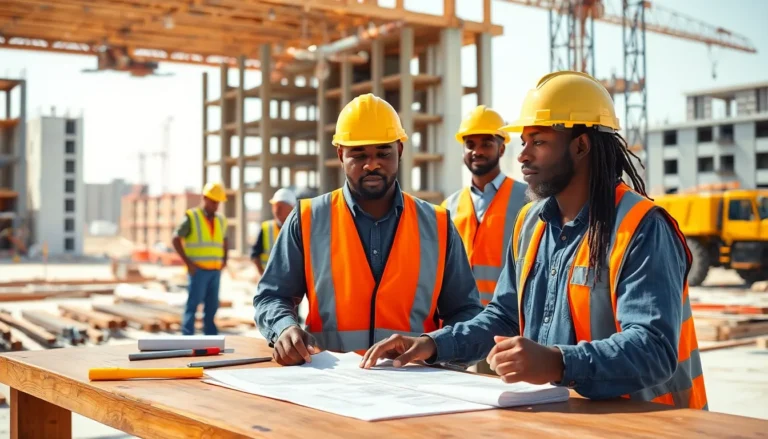Table of Contents
ToggleWhen it comes to monumental feats of architecture, some structures take their sweet time to rise from the ground. Ever wondered which building holds the title for the longest construction? Spoiler alert: it’s not your neighbor’s DIY shed that’s been under construction since the dawn of time.
Overview of Long-Build Projects
Several architectural projects throughout history have taken an extensive amount of time to complete. Examples of these projects highlight various factors influencing prolonged construction durations.
One notable structure is the Sagrada Família in Barcelona, Spain. Construction began in 1882 and continues to this day, making it an ongoing masterpiece with over 140 years of work. Anticipated completion is around the year 2026, coinciding with the centenary of the original architect, Antoni Gaudí’s death. This basilica’s intricate design and artistic features demand meticulous craftsmanship, extending the overall build time.
Another example is the Berlin Cathedral in Germany. Construction started in 1894 and concluded in 1905, taking 11 years. Although completed relatively quickly by comparison, the project underwent significant modifications that contributed to its complexity.
The Great Wall of China represents a different category, with various sections constructed over centuries. This monumental structure’s work spanned from as early as the 7th century BC to the 16th century AD. Climatic challenges and logistical issues contributed to the expansive timeline.
Infrastructure projects also face delays, such as the new International Airport in Istanbul. Construction started in 2015, with a phased opening extending through 2028. This massive undertaking reflects urban development trends while supporting a growing demand for air travel in the region.
Long-build projects reflect a variety of influences, from design intricacies to historical context. Each structure tells its own story, emphasizing human endeavor’s role in shaping the built environment.
Historical Context of Building Lengths

Building durations reflect the complexities of their eras. Various factors contribute to the length of construction, including technological advancements and available resources.
Ancient Structures
Ancient structures often required extensive time due to their monumental scale and the rudimentary tools available. The Great Pyramid of Giza, constructed over 20 years, showcases early engineering marvels. Furthermore, monumental temples, like the Parthenon, took years to complete, as artisans meticulously crafted their designs. Labor-intensive methods, such as using manual tools and transporting heavy materials, also slowed progress. These aspects underscore the challenges faced by ancient civilizations as they endeavored to create lasting legacies.
Modern Structures
Modern structures symbolize not only architectural ambition but also advancements in construction techniques. The Sagrada Família stands out, with construction ongoing since 1882. This complex design combines intricate aesthetics with modern materials, illustrating how contemporary craftsmanship influences timelines. The International Airport in Istanbul also highlights today’s trends, with phased openings planned until 2028. Each project’s timeline reflects societal demands, technological innovation, and cultural significance, emphasizing the intricate balance between ambition and execution in modern architecture.
Notable Long-Building Projects
Many architectural endeavors showcase extensive construction durations, revealing historical and cultural significance. Several remarkable projects illustrate this phenomenon.
The Great Wall of China
Construction of the Great Wall of China spanned several dynasties, beginning in the 7th century BC and continuing until the 16th century AD. This monumental structure reflects the need for defense against invasions, facing challenges like harsh climates and difficult terrain. Over centuries, various emperors contributed to its expansion and reinforcement, utilizing local materials to adapt to regional differences. Estimated to stretch over 13,000 miles, the wall’s complexity and scale contribute to its long-term construction, showcasing the vast labor force and resources employed throughout Chinese history.
The Colosseum
In Rome, the Colosseum took approximately eight years to complete, with construction occurring from 70 AD to 80 AD. This iconic amphitheater symbolizes both the architectural prowess and the dramatic public spectacles of ancient Rome. Events such as gladiatorial contests attracted thousands, underscoring the structure’s importance to Roman society. Innovative engineering techniques, including the use of concrete, allowed for its vast and intricate design. Challenges like political upheaval and funding fluctuations influenced its timeline, yet the Colosseum remains a testament to ancient Roman ambition and engineering skill.
The Sagrada Familia
Construction of the Sagrada Familia began in 1882, driven by architect Antoni Gaudí’s vision for a uniquely designed basilica. It’s expected to reach completion by 2026, aligning with the centenary of Gaudí’s passing. Intricate details and splendor characterize its design, demanding exceptional craftsmanship. Diverse funding sources and meticulous construction processes contribute to the prolonged build time. Moreover, the ever-evolving architectural elements reflect changing artistic trends and societal demands. The Sagrada Familia serves as a symbol of faith and devotion, encapsulating over a century’s worth of human effort and ambition.
Factors Contributing to Lengthy Construction
Lengthy construction projects often arise from a combination of various factors. Each element plays a critical role in determining the overall duration of the build.
Material Availability
Material availability significantly impacts construction timelines. Limited access to specific resources can cause delays. For instance, unique stone types for historical buildings may require sourcing from distant quarries, prolonging transportation times. Seasonal weather can also affect supply chains, impacting material delivery and inventory management. Projects like the Sagrada Família experience these challenges as artisans seek high-quality materials for intricate designs. These nuances underline the importance of planning and logistics in construction.
Political and Economic Influences
Political stability influences long-term construction projects. Shifts in government policies can disrupt funding and project priority. Historical events, such as wars or economic downturns, often halt work on significant structures. The Berlin Cathedral faced interruptions due to political changes during its construction. Fluctuating economic conditions affect funding availability, leading to pauses or modifications in project scope. Long-build projects must adapt to these external influences to stay on schedule.
Technological Advances
Technological advances reshape the construction landscape. Innovations improve efficiency and safety, but they can also complicate processes. For instance, modern construction techniques, while beneficial, may require substantial time for skill training among workers. The introduction of advanced machinery can also necessitate design adjustments. Projects like the Istanbul Airport illustrate this trend, where state-of-the-art technology enhances outcomes but extends timelines. Embracing innovations becomes essential to balancing speed with quality in construction projects.
The exploration of the longest construction projects reveals a fascinating intersection of history, culture, and human ambition. Each structure tells a unique story shaped by the challenges faced during its creation. From the intricate designs of the Sagrada Família to the monumental scale of the Great Wall of China, these buildings reflect the dedication and perseverance of those who brought them to life.
Understanding the complexities behind these lengthy projects offers valuable insights into the evolution of architecture and construction techniques. As society continues to push the boundaries of design and engineering, the lessons learned from these monumental endeavors will undoubtedly influence future projects, reminding us that great achievements often require time, patience, and unwavering commitment.







